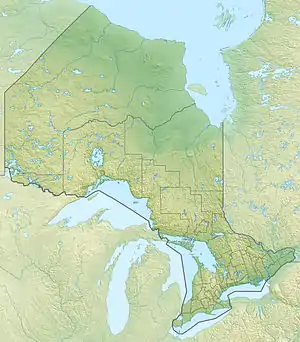Nipigon River
The Nipigon River is located in Thunder Bay District in Northwestern Ontario, Canada.[4] The river is about 48 km (30 mi) long[1] (or 209 kilometres (130 mi) when measured to the head of Ombabika River[2]) and 50 to 200 m (160 to 660 ft) wide, and flows from Lake Nipigon to Nipigon Bay on Lake Superior at the community of Red Rock, dropping from an elevation of 260 to 183 m (853 to 600 ft). It is the largest tributary of Lake Superior.[5]
| Nipigon River | |
|---|---|
 Nipigon River viewed to the south, with Nipigon Bay in the distance | |
 | |
| Location | |
| Canada | |
| Province | Ontario |
| District | Thunder Bay |
| Physical characteristics | |
| Source | Lake Nipigon |
| • coordinates | 49°27′35″N 88°13′00″W |
| • elevation | 259 m (850 ft) |
| Mouth | Nipigon Bay |
• location | Red Rock |
• coordinates | 48°57′42″N 88°15′00″W |
• elevation | 184 m (604 ft) |
| Length | 48 km (30 mi)[1] |
| Basin size | 25,400 km2 (9,800 sq mi)[2] |
| Discharge | |
| • location | Alexander Generating Station |
| • average | 350 m3/s (12,000 cu ft/s)[3] |
| Basin features | |
| River system | Great Lakes Basin |
| Waterbodies | Helen Lake |
| Bridges | Nipigon River Bridge, CP Railway Bridge |
Since 1943, 14,360 square kilometres (5,545 sq mi) of the Ogoki River basin has been diverted to the headwaters of the Little Jackfish River, a tributary of Lake Nipigon. This diversion increases the size of the river's watershed by almost 60% to 39,760 square kilometres (15,350 sq mi), and contributes an average of about 116 cubic metres per second (4,100 cu ft/s) to the Nipigon River.[6][7] This increased flow has caused significant erosion and landslides along the river.[5]
History
The Nipigon River was formerly known for the size and quantity of the brook trout that were to be found there. However, four dams built on the Nipigon led to a major decline in their population. The four dams are as follows:
- Cameron Falls Dam built in 1918
- Virgin Falls Dam built in 1925
- Alexander Dam built in 1930
- Pine Portage Dam built in 1950
Modern uses
Three hydroelectric dams on the Nipigon, Cameron Falls Dam, Alexander Dam, and Pine Portage Dam (all operated by Ontario Power Generation),[8] provided 2,144 gigawatt-hours in 2000.[9] This however effectively makes travel via boat between Lake Nipigon and Lake Superior impossible. The river is also a popular fishing destination.
| Installation (in downstream order) |
Capacity | Head[10] | No. of units |
Year built |
|---|---|---|---|---|
| Pine Portage Generating Station | 145 MW | 32 m 105 ft | 4 | 1950 |
| Cameron Falls Generating Station | 92 MW | 22 m 72 ft | 7 | 1920 |
| Alexander Generating Station | 69 MW | 18 m 60 ft | 5 | 1930 |
Fishing
46 fish species have been identified in the Nipigon River, including the rare sturgeon, cisco, and “coaster” brook trout.[5]

In 1915, Dr Cook caught the world record for the largest brook trout, also known as speckled trout or coaster trout. Four years later, Prince Edward, Prince of Wales (later King Edward VIII and Duke of Windsor), spent time fishing on the Nipigon; a trout that he caught was mounted and today is displayed at the National Archives of Canada.[11] The river also has a run of lake trout, rainbow trout and salmon during various times of the year. Fish that migrate up the river are able to get to the first dam which is located approximately 15 miles (24 km) from the mouth of the river system. The reservoir between the dams are good fishery, especially for large speckled trout and lake trout.
Fishing starts the first of May until freeze up at the end of November. The river can be accessed from boat, or fished by shore from various strategic locations.
See also
References
- "Lake Nipigon - lake, Ontario, Canada". www.britannica.com. Encyclopaedia Britannica. Retrieved 17 October 2022.
- "The Atlas of Canada - Rivers". Natural Resources Canada. 2010-10-25. Archived from the original on 2013-01-22.
- "ALEXANDER GS Watershed Conditions" (PDF). Ontario Power Generation. Retrieved 17 October 2022.
- "Nipigon River". Geographical Names Data Base. Natural Resources Canada. Retrieved 2013-04-01.
- Canada's Rivers at Risk (PDF) (Report). WWF-Canada. Fall 2009. Retrieved 18 October 2022.
- United States Great Lakes Basin Commission (1974). Great Lakes Basin Framework Study. [report] - Appendix. Public Information Office, Great Lakes Basin Commission. Retrieved 17 October 2022.
- "An Overview of Great Lakes Diversions". International Joint Commission. Retrieved 29 September 2021.
- "Hydroelectric power". www.opg.com. Ontario Power Generation Inc. Retrieved 18 October 2022.
- "Chapter 2: Ecological Land Use and Resource Management Strategy" (PDF). Lake Nipigon Conservation Reserve Resource Management Plan. Ontario Parks. July 2003. Archived from the original (PDF) on 2012-02-11. Retrieved 2013-04-01.
- United States. Army Corps of Engineers (1957). Effect on Great Lakes and St. Lawrence River of an Increase of 1000 Cubic Feet Per Second in the Diversion at Chicago. U.S. Army. Retrieved 18 October 2022.
- Whalen, James. "Royalty on the Nipigon". Brook Trout Heaven. Retrieved 2013-04-01.